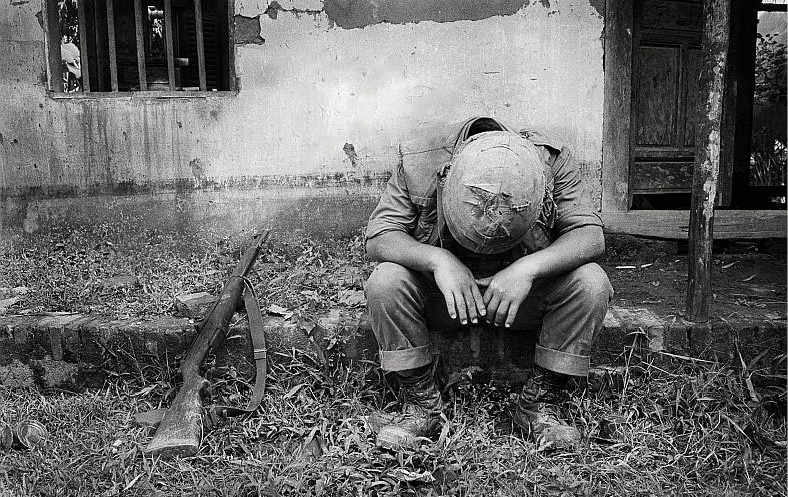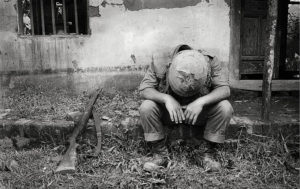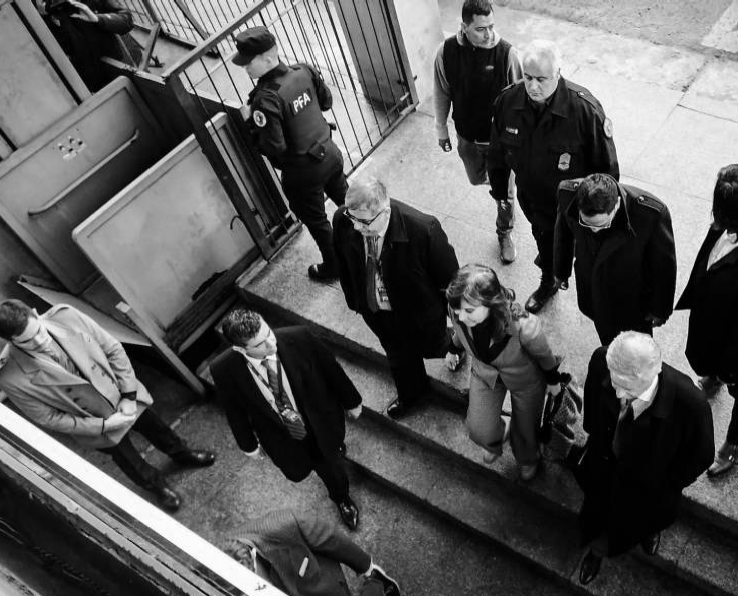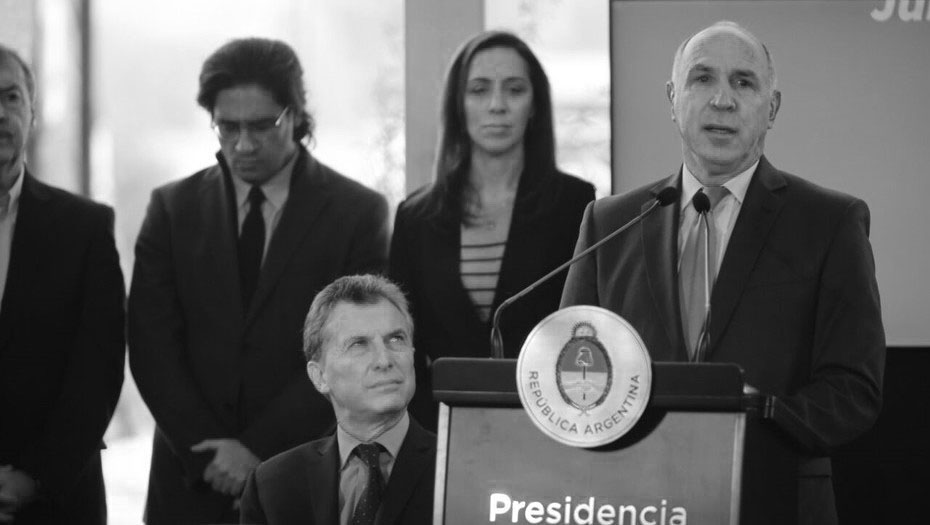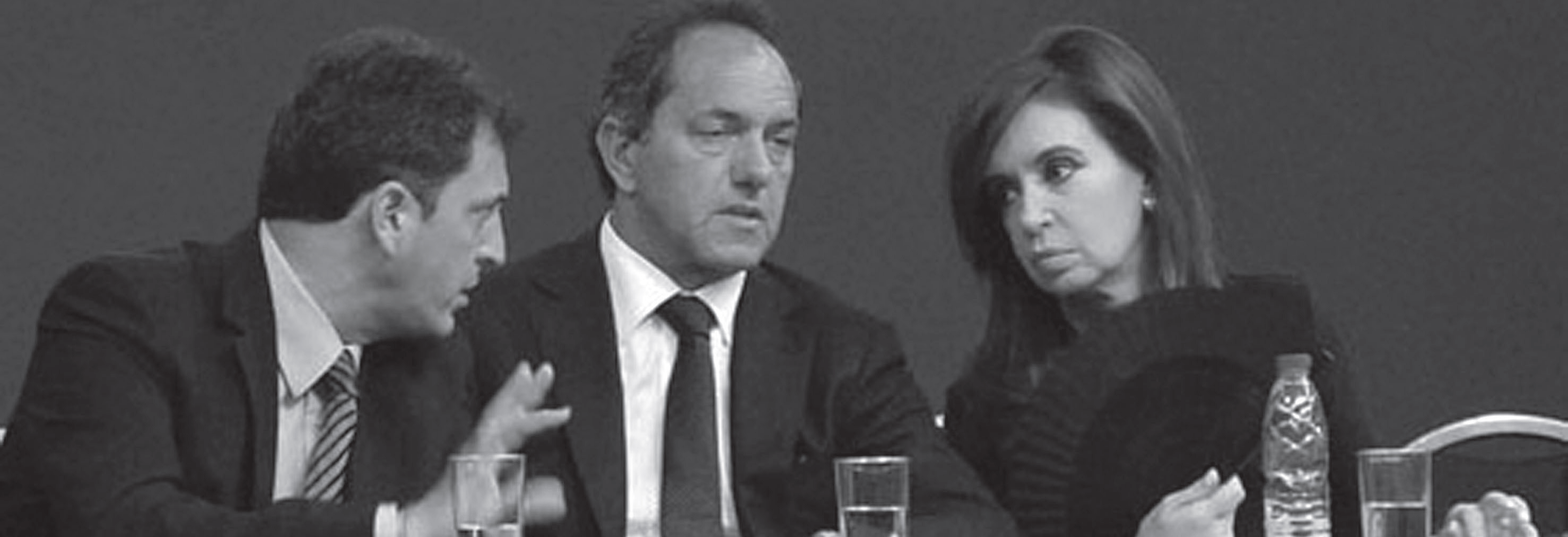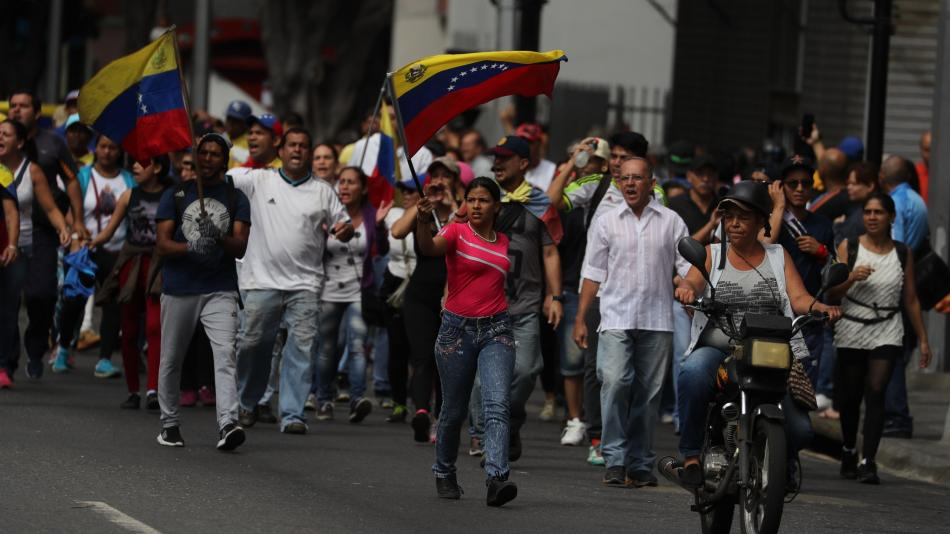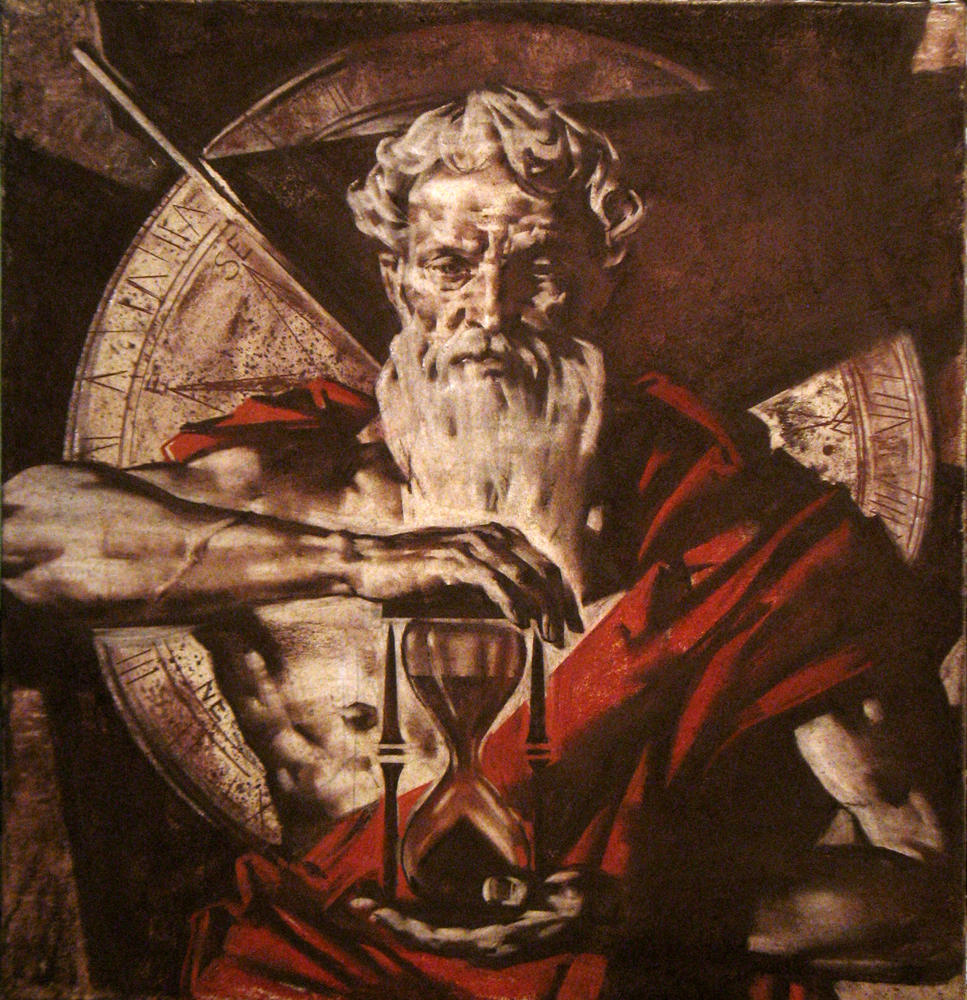Last presidential elections marked the begining of the end for the political alliance which governed the country for more than a decade. Kirchnerism is becoming part of the past: its political staff began running away and the breaks soon arrived. In this article we examine the details of this process.
Federico Genera (Political analysis laboratory- CEICS)
Nothing lasts forever…
The Front for Victory (FPV, Frente para la Victoria) was created in the year 2003 to hold the presidential race for Néstor Kirchner, Santa Cruz governor for the Justicialist Party (PJ, Partido Justicialista). The political crisis of the year 2001, imposed the need to form a more wide open front. Thus different sectors , including the Communist Party, the Humanist Party and organizations linked to the Piquetero (picket) movement, took on the task of rebuilding the burgeoise hegemony. This alliance had an important share of PJ members, which provided much of its party and territorial structure at a national level.
Twelve years later, this alliance comes to an end and the FPV is going through a process of decay. The “purest” kirchnerism- this means the organizations which were part of United and Organized, under commandment of La Cámpora- is paralyzed. As we stated before1, La Cámpora was no other thing than a group of state officials. All of its militant vocation was tied to the ANSES (National Social Security Administration ) cash. The new government not only swept its founds – A ruling by the Supreme Court ordered to give back to provinces co-participation founds enmarked for ANSES- but they also got rid of a good share of its staff. And to make things worse the main referent from La Cámpora from this area -Diego Bossio- already broke ranks. This loss of the State didn’t find them “resisting with endurance” in the streets. The demostrations for the liberation of Milagro Sala showed that the mobilization capabilities of United and Organized is at its lowest point (for some organizations is null) and surpassed by the left, even when it wasn’t mobilized in full capacity. In short, neither on the State nor on the streets.
If this happened with the “hard core” kirchnerism, what can be expected from the historical PJ sectors which supported it, but the absolute runaway. In fact, this alliance was always unstable. Its viability depended on the ability of Néstor and Cristina to stay in front of the executive power. This allowed them to have the governors aligned using the State found to create public works and to sustain their territorial links. Today without those funds, the governors are in the need to support Macri or they risk to lose it all. Let’s see then, in a more detailed way, how the political staff of theFPV is aligning in relation to the PJ and the Macrism.
The Outbreak
For the 2015 elections, La Cámpora proposed its own candidates for the national deputy charges, while the Justicialist Party mantained the governations and some senators. Until that moment, the party gave in to them, because they owned the State and the provinces live thanks to the funds given by the National government to sustain the public work, employment and subvention policies. A crisi during an electoral period could translate to a defeat for the governorates, much like the case of Jujuy -historically governed by the PJ- where a division of forces ocurred within the FPV. The government decided not to benefit the PJ, but the related organization Tupac Amaru, conducted by Milagro Sala.
It was not long after the national electoral defeat that the attrition process began. The first break of CFK conduction was during the assumption of Mauricio Macri in the Congress. The order was not to assist to the ceremony. The PJ, however, disobeyed the ex president and Scioli, Urtubey, Alperovich, Manzur, Insfrán, Beder Herrera and Rosana Bertone among others were present. A small sample of what was coming.
Then the PJ in the Buenos Aires area broke the senator block. The 17 members were divided into two blocks. Nine enlisted behind Daniel Barrera, a man linked to the Buenos Aires mayors from the PJ, close to Fernando Espinoza from La Matanza.The other group of eight senators, among them Sergio Berni, stayed under the conduction of Magdalena Sierra, a member of La Cámpora. This division implied for the Cambiemos block the first minority in the provintial senate.
But the strongest rupture happened during the end of january, in the epicenter of the national legislative. From within the FPV block emerged the Justicialist Block. Twelve deputies decided to leave Cristina behind, led by Diego Bossio. He was joind by Oscar Romero (SMATA, Automobile mechanics union), Carlos Rubin (Corrientes), Evita Isa (Salta), Pablo Kosiner (Salta), Javier David (Salta), Guillermo Snopek (Jujuy), Héctor Tentor (Jujuy) Néstor Tomassio (Catamarca), Rubén Mirando (Mendoza), Gustavo Martinez Campos (Chaco), Teresita Madera (La Rioja). These are not marginal characters for kirchnerism, they colaborated with them while they were government. Romero assisted with an affirmative vote for the 82,46% of the votings, Madera and Tomassi with a 91,23%, Isa with 98, 25% and Rubin with 100%. With their votes important laws passed like the Reform of the Criminal Code, the Agreement on cooperation in economic and investment between Argentina and China and the reform of the Intelligence law.
This block, now directed by Oscar Romero added other members: Sergio Ziliotto (La Pampa), Alberto Roberti (formerly with Sergio Massa, Buenos Aires), Oscar Macías (Buenos Aires), Gustavo Fernández Mendía (La Pampa) and Luis Beder Herrera (La Rioja). It was finally comprised by 17 National Deputies, supported by Juan Manuel Urtubey (Salta), Domingo Peppo (Chaco), Segio Casas (La Rioja) and Rosana Bertone (Tierra del Fuego) and Carlos Verna (La Pampa) which already broke relations with kirchnerism before.
The “rupturists” have a history with the PJ. In this sense, the disidents argued that in the kirchnerist block there was no place for differences and that, by CFK command, the conduction of the parliamentary group took some decisitions withoud discussing them, like making a criminal complaint against government officers for the decrees passed by Macri during the first days of his term. Bossio, in the middle of the criticism from the spiteful kirchnerism, he received a call from Sergio Massa. This approach will also have an impact in the Chamber of Deputies, where the new group will try to work on different subjects in coordination with massism. Not for nothing Massa said that “as Macri needs to pass legislations in congress, we will ask for the support of the Pink House for the claims of governors and unions and, at the same time, from the deputies from those governors and unions for our projects”2. A clear statement of his political strategy intentions. Another key backing that the new block is managing to get, with the leadership of Bossio and Urtubey, is the one from the unions. The meetings they mantained in the SMATA headquarters with Ricardo Pignanelli and with Omar Viviani from the Taxi Drivers Union gave an account of this. This goes with the agenda that is being made by the deputies who left the FPV in which the unions subject will be present. The main claim is the rise of the floor for the income tax and the VAT refunds.
In this sense, the alignment of the rupturists seems to be clear. With the sinking boat of kirchnerism,the new block pretends to be the voice of the governors who need to be close to Macri- because of the resources- and the ones that Macri needs to govern. In Fact, the rupture
altered the perspective for the Congress. Kirchnerism went from 95 deputies to 78. This is why it stopped being the first minority which now is the Cambiemos (Let’s Change) block with 92 parliamentarians. It is important to notice that Macrism won’t need to negotiate with kirchnerism to reach quorum (129 deputies) , this can be done with the Justicialist Block, the Massist front “Una Nueva Argentina” (A new Argentine) with its 35 deputies and with the alliance conformed with those who answer to Rodriguez Saa and the ex massist Giustozzi, “Compromiso Parlamentario por la Argentina”(Parlamentary commitment for Argentine) with 9 deputies, an alliance which already guaranteed quorum.
The Rearming
Part of the rearrangement of the PJ supposed the need of resources to rule and the national government – as they announced- will colaborate with this, because they want to keep this staff on their side. Otherwise, this relationship would have been in danger because of the claims of the governors and the possibility of a political defeat in Congress.
This is the reason why the government, from the judgement of the Supreme Court, accepted the State to give back to provinces over a term of 5 years, the 15% of the federal co-participation retained by the Nation since 1992. To accomplish this Mauricio Macri created the Argentinian Council for the new Federalism -composed of the Minister of Interior, the governors of each province and the mayor of Buenos Aires- which establish a deadline on the first of january of 2021 to pay the debt. This will be done staggered and annually until 2021.3
It was Sergio Massa who got his conditions imposed in the Pink House to agree with the return. This also opens the round of negotiations between the national government and the league of governors. These and the mayors, this is to say the ones who got executive charges, are the most commited to make agreements with the national government.
In this sense, another resource base is the public work. The Belgrano Plan propposed by Mauricio Macri works as an example. This infrastructure plan projects investments for 16 billion dollars in 10 years, a fund of historical reparation of 50 billion pesos in 4 years, housing subsidies for 250.000 families, among other measures. It doesn’t seem casual that this propposal points to benefit the provinces of the north: Salta,, Jujuy, Tucumá, La Rioja, Catamarca, Misiones, Corrientes, Chaco, Formsa and Santiago del Estero, some rules by the FPV. We will have to see how much these kirchnerist “convictions” last.
This rearrangement of forces can be clearly seen on the PJ Congress which had place the past 24 of february. What happened there not only confirms the vanishing of La Cámpora and the rearrangement of some kirchnerists in an individual way in the PJ, but also of the positioning of the majority of the PJ around Macrism.
The main subjects discused in the congress were: 1) The voting for the lock law, which divided those who still support the FPV from those who won’t.2) The removal of the aliquot for the high end automobiles.3) The voting for the folio of 14 macrism ambassadors.4) The confirmation of the candidates lists.
From the Congress, an intern appears which shapes two positions within the PJ. One can be seen through the sectors more prompt to dialogue which prioritizes the “governability” and accompany some policies of the national government. On the other hand, a group more identified with the kirchnerist administration.
Around the derogation of the lock law propposed by Macrism, the kirchnerist wing of peronism, asked to forbid the legislators to join Macri in this subject. The lock law is a norm dictated under kirchnerism and today difficults the country to make a better offer for the “vulture funds” and the holdouts than those accepted by the bondholders who entered the exchanges of 2005 and 2010. This is why Macrism wants to repeal it and is going to send three projects to the Congress to accomplish this. A week before the Congress, during the Buenos Aires PJ meeting, the deputy Teresa García, one of the most angered by Bossio, raised the idea of a prohibitive clause for the party to prevent their members deputies/affiliates from treating initiatives that include indebtedness by the Executive. In relation to this, it’s been said that Cristina send part of the staff left to move along this guideline. This has to do with the opposition of the kirchnerist wing to the possibility of Macri getting loans so he can finance his political program. During the party congress, one of its defendants was Jorge Ferrareso, Avellaneda’s mayor and local PJ president. He said that the slogan remained to be “Vulture funds or Argentine” and that they expected from the Congress a clear position against the indebtedness and the legislators to submit to the PJ will so they don’t vote for the repeal of the lock law.4
Paradoxically, the opposition to this propposal came from Miguel Pichetto, president of the parliamentary group of the FPV in the Senate and more related to the “dialogist” sectors, who rejected the possibility and said that the correct thing will be decided in the Congress, giving into account that there are no links with the kircherist block. It seems like this matter was a turning point and there was no agreement about it, which means a defeat for the K sectors, whenever they couldn’t impose the prohibitive clause.
On the derogation of the aliquot for high end vehicles, three senators identified with the traditional peronism made an alliance to avail the decree passed by Macri. The most shocking thing about this was that Juan Manuel abal Medina also joined the president and was accompanied by Juan Irrazabal, Juan Pais and Graciela de la Rosa. Pichetto also confessed that his party never agreed to increase taxes for luxury cars. On the ambassadors folio, kirchnerism got defeated again: they tried to veto Ramón Puerta (who recently exclaimed: “Kirchnerism is disbanding, thanks to God”) as a candidate for the Spain ambassy and Miguel del Sel for Panamá. However, the folio was approved.
As for the creations of the lists, the camporists tried to resist the idea of a single list led by José Luis Gioja, but they lost the fight one more time. Gioja supported both kirchnerist terms, but today he seems to be closer to the national government. In the eviction of the offices he was not affected.5 Even on his sayings a critical view to kirchnerism – which by the way is in line with the rupturists- and an approach to the national government can be noticed. Specifically, with the end of the PJ Congress, Gioja said that “today there is no more a vertical conduction like when we were ruling, today things are discused in another way”6 and deepened saying “there was a way to conduct when were government: to be ruling aligns, generates important party discipline, things that relax when things go the way they went and we are opposition. Now we have to make an effort to coincide”7. As for his approach to Macri he did directly, when he expressed his first agreement on the removal of mining taxes. But also indirectly, when he reported that the peronists who belong to the Frente Renovador (Renewal Front, FR) led by Sergio Massa, have “open doors” in the PJ.
Kirchernism can’t get to conform its own electoral alternative. The ones who took charge of the kirchnerist resistance- including the governor of La Pampa, Carlos Verna and his vicegovernor, Mariano Fernández- argue that the ex president carries no weight in the PJ intern. Mariano Recalde taking in account this scenario got ahead of himself and held that in the PJ Congress they wre also talking about unity and that they didn’t want to discuss proper names but they intended to practice self-criticism. Agustín Rossi, ex-minister of defense, said that the affiliates should be the ones to choose the authorities of the party and not the congressmen, showing that the kirchnerist wing has lost everything inside the Congress- and hardly will aglutinate something from the outside with their eternal “campaign” of affiliations. Trying to cool things out, Juan Cabandié 8 stated that the important thing were the salary negotiations, the adjustment and the super rate hike, that everything “will eventually resolve ”, which probably means that they would silently support the unity list in april. It’s not casual that the Electoral Board majority is conformed by the traditional peronism. Of the 14 charges only one was offered to La Cámpora, a propposition rejected by the organizaction justifying this decision because they prefered to “give it to a mayor or governor”, maybe to conserve some dignity due to minority position they were condemned.
The Cracking
As we stated before,9 during its twelve years, kirchnerism never accomplished the goal of constructing and own and lasting political structure. Its strenghts were having the State cash to discipline the governors and mayors and to sustain the “militancy”. Today, whithout this key factor, all the assembly vanishes. The “militants” can only fill squares with pompous figures, but have scarce movilization capabilities and no relationship with the unions. They still have seats in the Congress, but because of their last rupture, macrism has green light to act without the need to negotiate with them. There doesn’t seem to be much chances for the “stadist” Máximo Kirchner (Néstor and Cristina son) to show his oratory and conduction skills…
Meanwhile the PJ rearranges for the new times. Tries to be on good terms with the macrism and plays the role of a light opposition (“responsible”), attempting this way to conserve the power and to start from the scratch in four years.
Both the PJ and the kircherism point to “resist with endurance”. But they are trying to maintain their structures and positions of power. It’s been a while since peronism is not a working class representative, beyond the links with their political point men. While they
dsitribute their assets and show the identity of their program with the one of the macrism, on this side of the world the adjustment, the super rate hike, the massive redundancies and so on, keep on going. This may seem like a truism, but in times of disorientation for the left, it’s important to remember that with this burgeoisie representatives there can be no only front.
Notas
1Genera, Federico: “A shadow soon you will be…”, in El Aromo, nº 84, may/june of 2015.
9Ver Genera, Federico: “Like we left it”, in El Aromo, n° 80, september/october of 2014.

